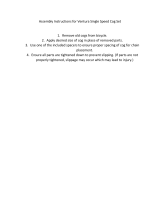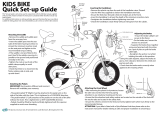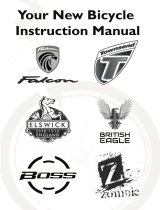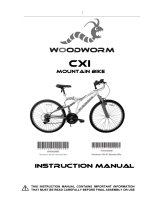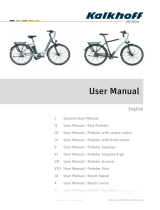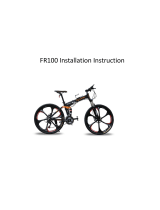
18
3I. BRAKES
It’s very important for your child’s safety that they learn and remember which brake lever controls which brake on your bike. Tradionally, the
le brake lever controls the rear brake and the right brake lever controls the front brake; but, to make sure your child’s bike’s brakes are set up
this way, squeeze one brake lever and look to see which brake, front or rear, engages. Now do the same with the other brake lever.
Make sure that their hands can reach and squeeze the brake levers comfortably. If their hands are too small to operate the levers comfortably,
consult your local bike shop before riding the bike. The lever reach may be adjustable; or you may need a dierent brake lever design.
How brakes work
The braking acon of a bicycle is a funcon of the fricon between the braking surfaces. To make sure that you have maximum fricon
available, keep your wheel rims and brake pads free of dirt, lubricants, waxes or polishes.
Brakes are designed to control your speed, not just to stop the bike. Maximum braking force for each wheel occurs at the point just before the
wheel “locks up” (stops rotang) and starts to skid. Once the tyre skids, you actually lose most of your stopping force and all direconal control.
You need to pracce slowing and stopping smoothly without locking up a wheel.
The technique is called progressive brake modulaon. Instead of jerking the brake lever to the posion where you think you’ll generate the
appropriate braking force, squeeze the lever, progressively increasing the braking force.
If you feel the wheel begin to lock up, release pressure just a lile to keep the wheel rotang just short of lockup. It’s important to develop a
feel for the amount of brake lever pressure required for each wheel at dierent speeds and on dierent surfaces. To beer understand this,
experiment a lile by walking your bike and applying dierent amounts of pressure to each brake lever, unl the wheel locks.
When you apply one or both brakes, the bike begins to slow, but your body wants to connue at the speed at which it was going. This causes a
transfer of weight to the front wheel (or, under heavy braking, around the front wheel hub, which could send you ying over the handlebars).
A wheel with more weight on it will accept greater brake pressure before lockup; a wheel with less weight will lock up with less brake pressure.
So, as you apply brakes and your weight is transferred forward, you need to shi your body toward the rear of the bike, to transfer weight
back on to the rear wheel; and at the same me, you need to both decrease rear braking and increase front braking force. This is even more
important on descents, because descents shi weight forward.
Two keys to eecve speed control and safe stopping are controlling wheel lockup and weight transfer. This weight transfer is even more
pronounced if your bike has a front suspension fork. Front suspension “dips” under braking, increasing the weight transfer. Pracce braking and
weight transfer techniques where there is no trac or other hazards and distracons.
Everything changes when you ride on loose surfaces or in wet weather. It will take longer to stop on loose surfaces or in wet weather. Tire
adhesion is reduced, so the wheels have less cornering and braking tracon and can lock up with less brake force. Moisture or dirt on the brake
pads reduces their ability to grip. The way to maintain control on loose or wet surfaces is to go more slowly.
























